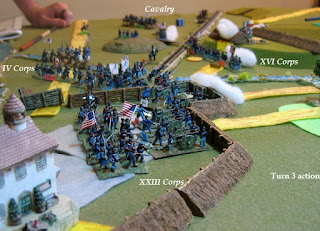Last night we played the Crimean War scenario of Kurudere, a
Russia vs. Turk scenario set
in the Caucasus in August 4, 1854. Warning: we don’t
have any of the correct figures for this but other BBB guys say the game is a
blast. We substituted Blucher’s Prussians for Russians and 1870 French for
Turks. If that truly offends you, please avert your eyes now. If you can
stomach that, read on. The game was a hoot and will deserve repeat attention
from us in the future.
Jay decided to play the Ottoman leader Mustafa Zarif Pasha,
seconded by Ken. I played Russian leader Prince Bebutov. The Russian force is
small and quite good. The Turkish host is rather bad but numerous. Nearly half
of the Turkish force arrives between turn 2 and 4, depending on the dice. The
Russians need 4 objectives for a victory. They start with 3. I needed to clear
the Turks off the highest Karayal plateau for a win and then get back in time
to keep the 2nd Division from taking the objectives I started with.
The Turks stepped off crisply, even though they are all
rated passive. My lads moved at a moderate pace. Early shooting showed low dice
for the Russians. This would continue until halfway through the game. My
assault dice would be moderate to hot. The bayonet is a good boy when wielded
in deep formation. But the 36-gun Turkish battery on the hill would break up my
early bayonet attacks.
Flanking fire by the smartly moving Turkish infantry would
halt more and cause serious losses. Who knew they could maneuver so well?
The Erivanski Grenadiers used cold steel to good effect.
Some of the Turkish Reserve escaped the wrath of Erivanski.
Back at the Karaval plateau, things went from bad to worse.
My infantry had to pull back to refit, beyond the long range of the Istanbul
Rifles. The Belevski Regiment was on life-support.
Following label is wrong: this is the Russian right flank.
My fire dice lit up.
And on my left:
On the Russian left:
On the last turn, the Turks failed to take any of the 3
objectives I held during their half of the turn. We decided to only play my
left flank, where I had a wisp of a chance of taking the Karaval plateau and
gaining a win. It seems the valiant Erivanski Grenadiers were exhausted after
winning 5 assaults.
And here’s the game end situation. Off-camera to the top,
the small Dragoon regiment is threatening the Turkish rear. Earlier they won 2
assaults.
We played 8 turns in 3 hours and 30 minutes. Russian losses
were 6 infantry stands (of 27) and 1 cavalry (of 14), about historical losses.
The Turks lost 10 infantry and 4 more fled (of 47), 9 cavalry and 3 fled (of 14)
and 2 guns (of 6). Turkish losses were less than the historical casualties. But
then the Russians won the real thing.
After playing numerous games with rifled artillery or
better, I was looking down my nose at smooth-bore artillery. Well, at effective
range they can be quite deadly when they are massed. They broke up my early
attack on the left and kept giving me trouble during most of the game, ceasing
briefly when they wheeled around to face the Dragoons dancing behind them. I ended
up making my final attack with the weakest elements of my force, Cossacks and
Muslim Irregular horse. Those are the folks who should have been raiding behind
enemy lines. That said, it was great fun having the Grenadiers smash through
the Turkish Reserve. I would love to play this again some time, either as the
Russian or commanding that big, crappy mob of Turks.
Fatigue has set in and we’ll be playing games every other
week for a while, rather than weekly.


































































